Rothenburg ob der Tauber Germany
It's a film star: The most romantic city on the Romantic Road of Bavaria Germany
One of the best known cities along the German Romantic Road, Rothenburg ob der Tauber has been inspiration for films of fairy stories as diverse as the Walt Disney 'Pinocchio' of the 1940’s, 'Chitty Chitty Bang Bang', and also as the home of the Japanese Manga, 'Sugar - a little Snow Fairy'. 'Harry Potter and the Deathly Hallows' saw Grindewald steal a wand from the house of Gregorovitch - filmed in the crooked streets of the town.
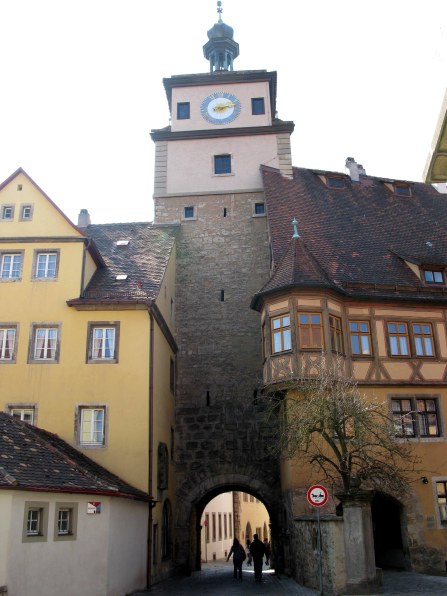
Standing in the market square it is easy to see why the place captures the imagination of those creating fantasies.
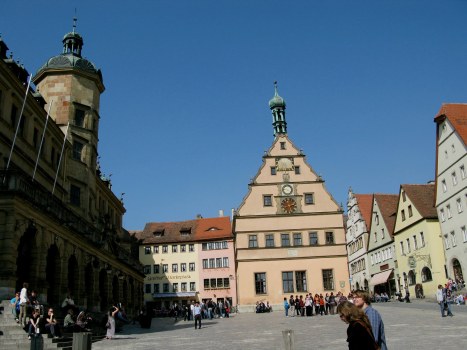
Rothenburg ob der Tauber Town Hall
The Rathaus or Town Hall spans a whole block.
The baroque-style arcade at the base was added in 1681.
Inside the arches are the coats of arms of the seven Electors of the Golden Bull of 1356
The Golden Bull - sealing many fates
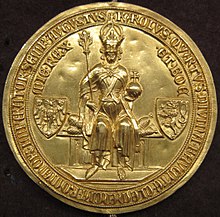
The Golden Bull was not a male bovine, but an edict of the Imperial Diet.
(An Imperial Diet is the highest representative assembly of an empire).
This one was sealed with a golden seal when Emperor Charles IV fixed important elements of the constitutional structure of the Holy Roman Empire for a period of more than 400 ensuing years.
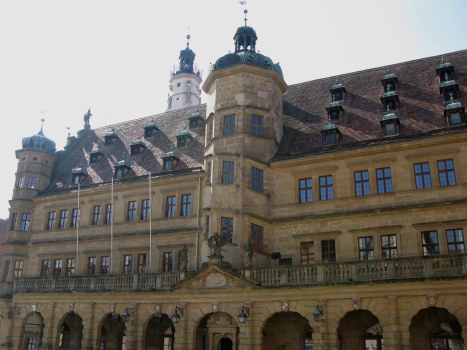
The coats of arms are for the Prince-Bishops of Cologne, Mainz and Trier, the King of Bohemia, the Count Palatinate of the Rhine, the Dukes of Saxony and the Margrave of Brandenburg.
Notably, the Hapsburg are absent and were not to gain an electoral vote again until they succeeded to the Kingdom of Bohemia in 1526.
Although no longer entitled a prince, the Bishopric of Mainz is the only one of the seven to retain nominal power - for it remains the only Roman Catholic diocese in the world other than Rome which bears the title of a Holy See, allowing its own cathedral chapter to elect a successor to its bishop.
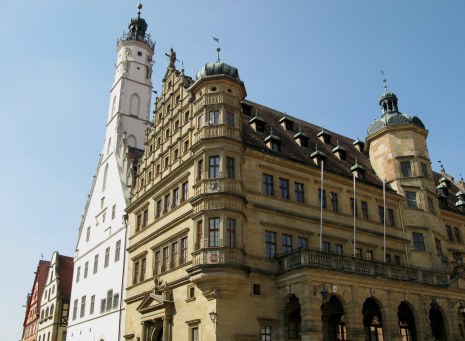
The side view of the Rathaus is as stately as that which faces the market square.
The original building of 1250 is captured still only in a painting on the main altar of St. Jakobskirche or St. Jacob's Church. It burned in 1501 although the bell tower is a lone surviving element of the original.
This new design was not the result of imported talent. Instead, the Rathaus was designed and built by local Master Builder Leonhard Weidmann: construction spanned the years between 1572 and 1578.
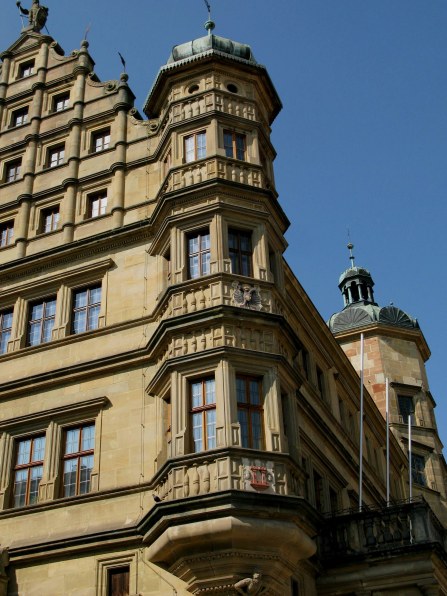
The Master Builder's House in
Rothenburg ob der Tauber
The commission for Master Builder Leonhard Weidmann must have been profitable. As architect/builder, he had great responsibility, and with that comes great reward. As is seen by the sign at the door, his own house was built in 1596, shortly after completion of theTown Hall. It is on the little laneway of Obere Schmiedgasse, but is now a cafe and restaurant.
The facade at the first level depicts the seven virtues:
Kindheartedness, Motherliness, Gentleness, Temperance, Courage, Justice and Wisdom - but above them are the cautionary seven deadly sins: Gluttony, Deception, Falsehood, Greed, Lust, Sloth and Vanity.
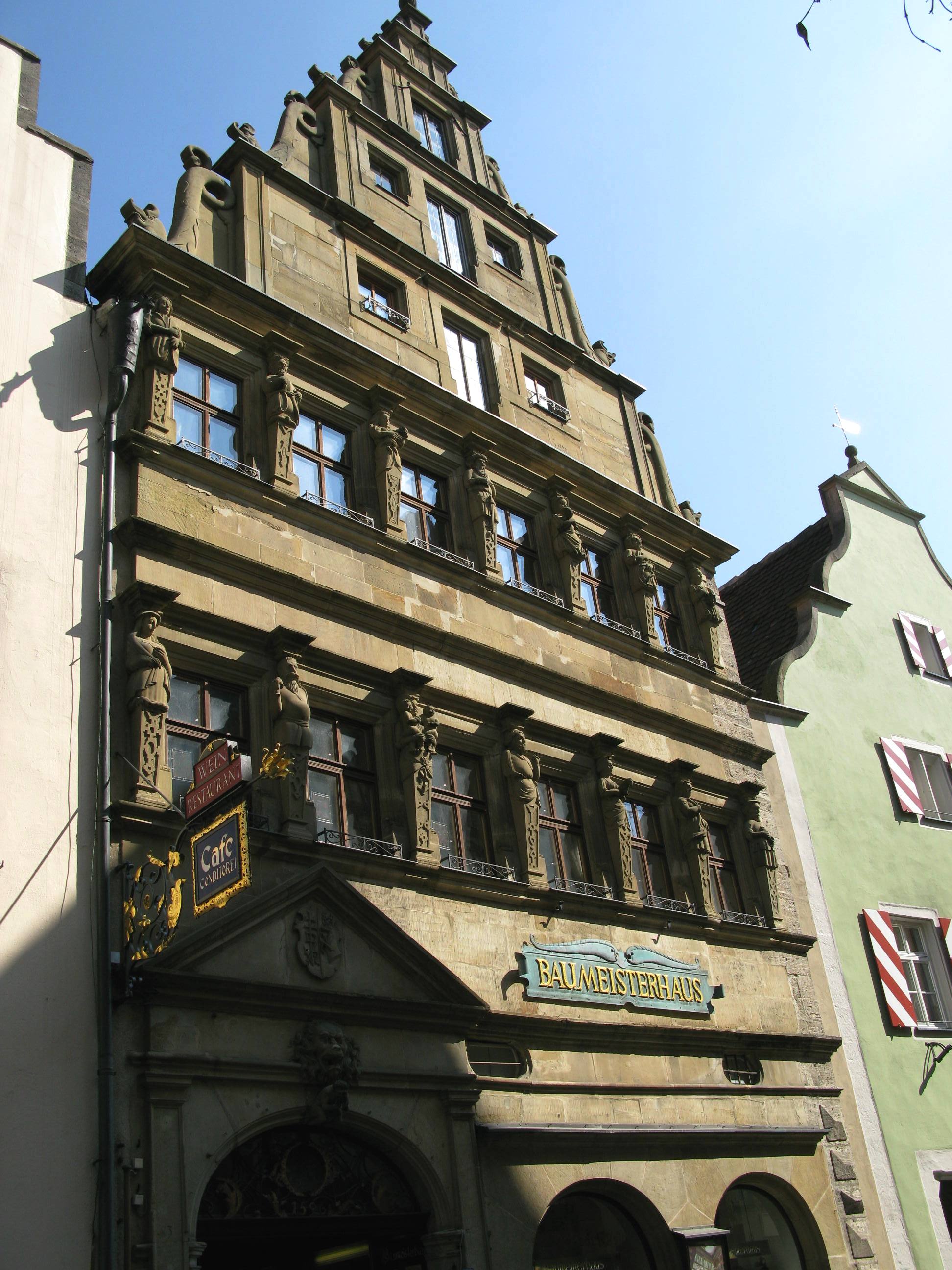
Rothenburg ob der Tauber
one of the last intact walled cities of Germany
Rothenburg ob der Tauber is translated as Red Fortress over the Tauber.
As 'rot' in German means 'red', it has been said that this refers to the red rooftops of the walled city.
Looking across from one section of the wall to another, you can see why.

This is especially so when you look up from the walls from below.
From these walls there are magnificent views.
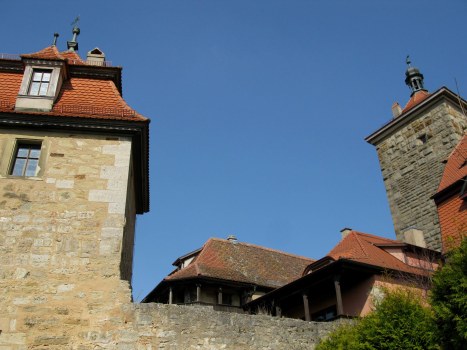
Rothenburg ob der Tauber snowballs
- even in summer.
If you wander the backstreets there are some very tiny verandahs attached to small cafés where you can buy not only the famous 'Snowballs' (in German 'Schneeballs') that are designed to be smashed into pieces to be eaten, but also sit and eat and look at the views in the privacy of just two or three tables.
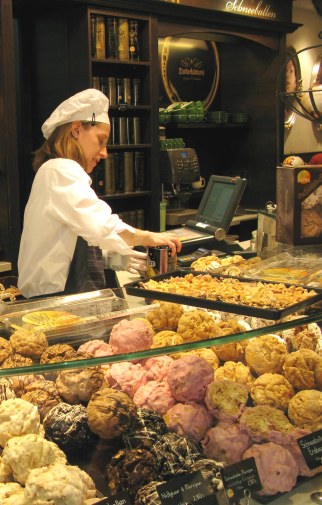
Towers and entrances
Of the towers that once regularly punctuated the walls, now only a few are left.
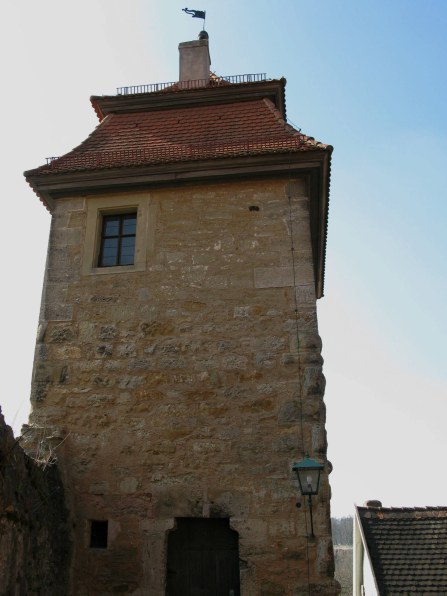
They are sturdy bastions – just as sturdy as the city gates.
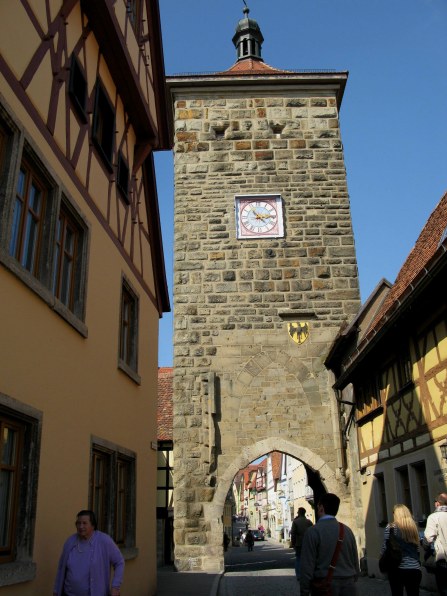
Quirky traditional hotels
of Rothenburg ob der Tauber
Within the walls are wonderfully romantic hotels - this one of that name.
Despite their old world charm, the facilities are first class modern , with a nod to the past as you see with the old typewriter in the guests' lounge beside the internet computer.
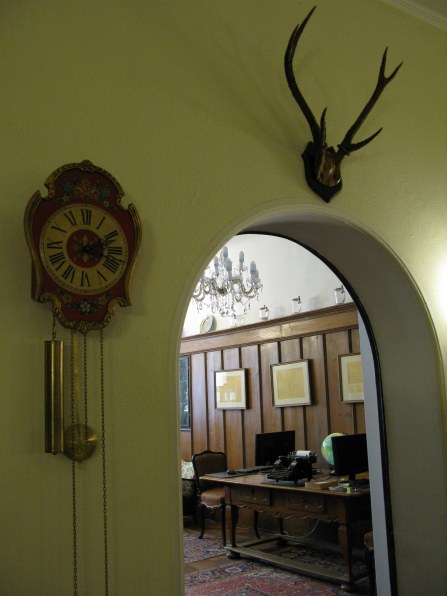
These are places to slow down and let the charm of centuries of good hospitality wrap around you.
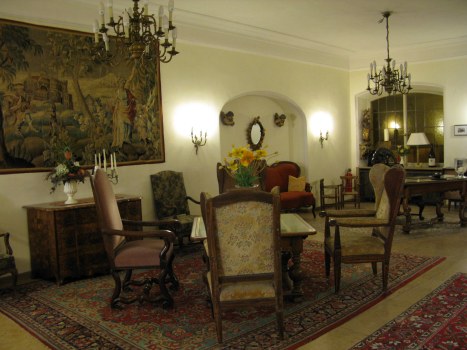
Rothenburg ob der Tauber:
traditional home of lace-making and fine linen
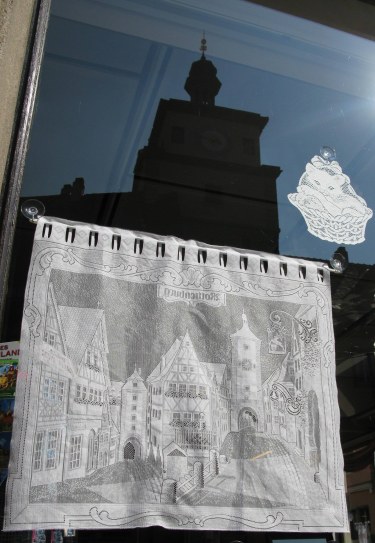
The name of Rothenburg ob der Tauber may also have some resonance with the retting (in German “rotten”) of flax to make linen – once a mainstay industry of the region.
You
can still buy fine linen products particular to the area from one of
the many shops that display fine work among their other souvenirs.
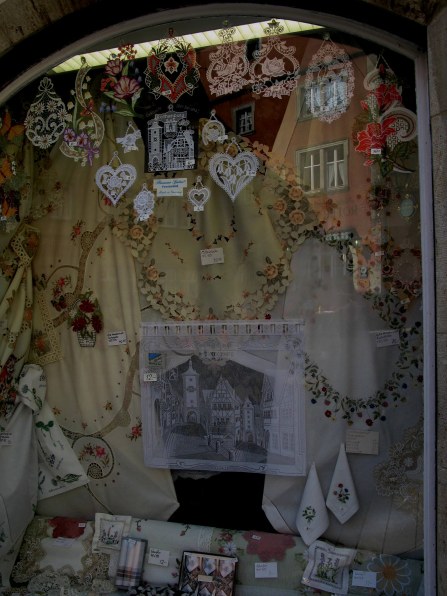
This wonderful walled city has been caught in the crossfire of political intrigue for centuries. Its strategic location was once an important stopping off point en route to Venice.
Later the town was impoverished by wars, attacks, raiding, and billeting of soldiers.
Having taken the protestant version of christianity over the Roman Catholic, the economic base of the region suffered.
For many it was wood carving and lace making and fine linen work that kept food on the table. The work that is still produced is beautiful.
Fairytale imagery - a photographer's delight
Walking its streets, you can see why Rothenburg ob der Tauber lends itself as a suitable backdrop for all sorts of books and stories.
A visit to it is like entering a fairy story yourself.
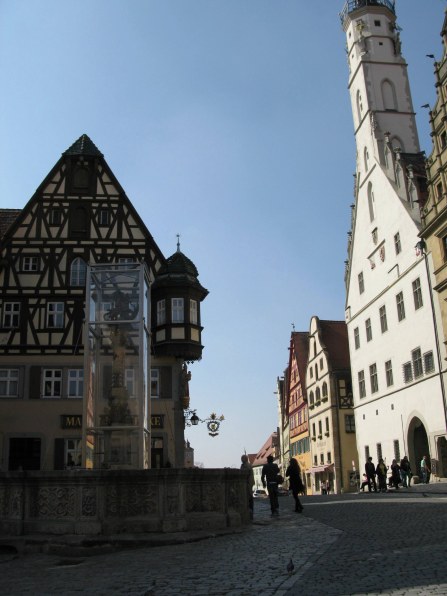
Rothenburg ob der Tauber
St. George's Fountain
My visit was on the way back from a ball in a beautiful Saal or hall in the Kunstlerhaus or Artists House in Munich, and in late March, St. George’s Fountain was still within its protective winter casing.
The winter coat is not removed until the beginning of April, as this protect the details of St. George, the protective saint of the Bavarian royal family, whose image here was created in 1608.
The well beneath St. George’s fountain is 8 metres deep, and with its capacity of 1,000 litres, it is the largest in a city where fountains proliferate, being important not just for drinking water, but for fire fighting.
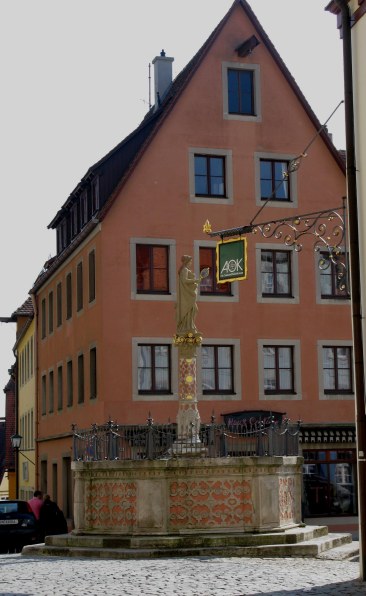
Fountains in Bavaria are usually encased in wooded “houses” or “hats” that sit over the top of them for the winter months.
Not here in Rothenburg ob der Tauber. Instead, visitors can enjoy not only St. George, but also the reflections of his surroundings offered by the sides of his protective winter encasement.
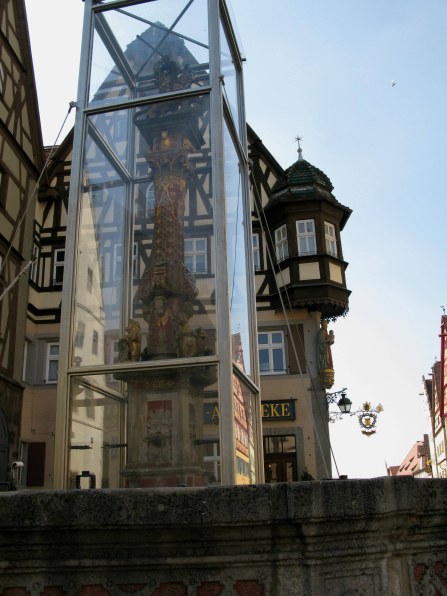
The Easter Parade of decor
in Rothenburg ob der Tauber
The city was dressed for Easter.
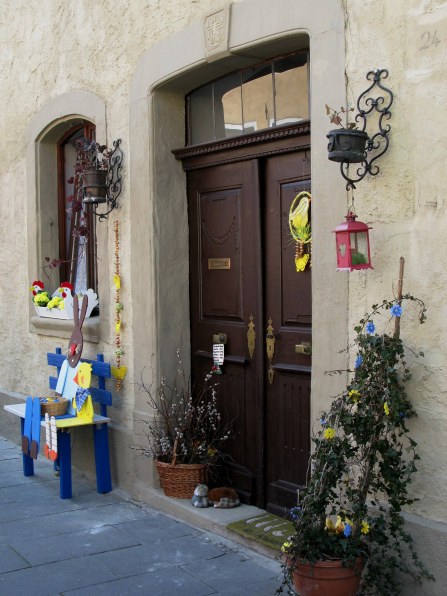
This was celebrated by decorating private houses...
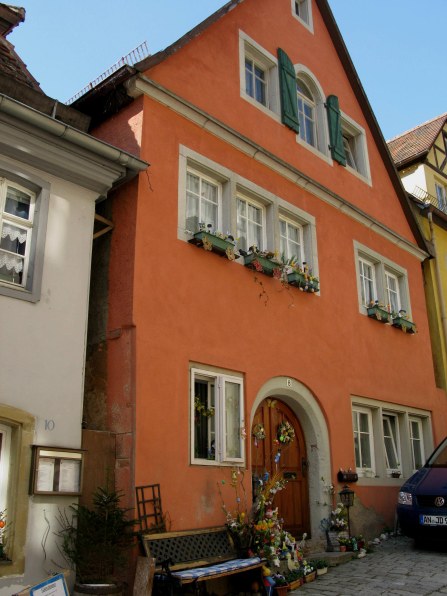
...as well as the shops.
Here the gift shop reflected the elaborate facade of the Master Builder's House.
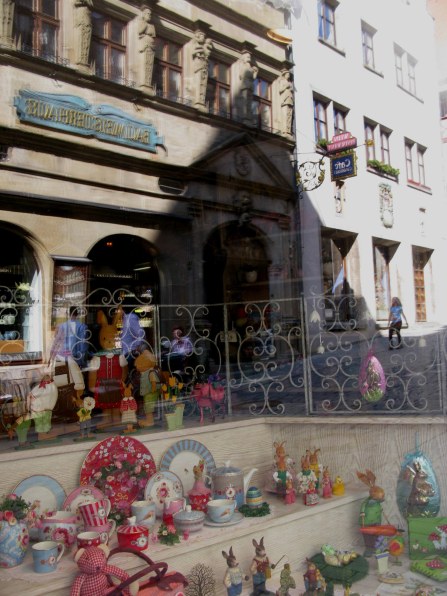
Other shop reflections capture the charm of one of Germany's most picturesque towns.
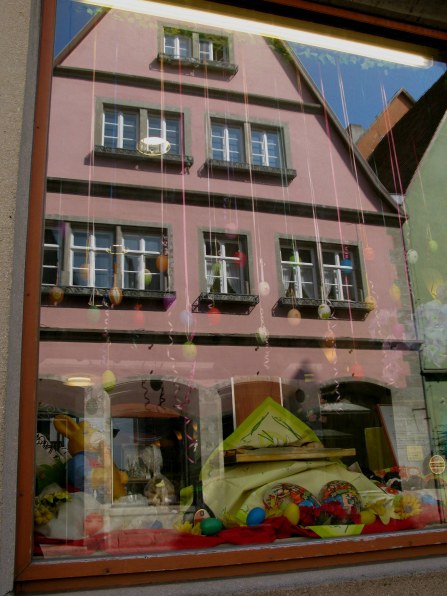
I love the way the reflections make a layered blending of imagery.
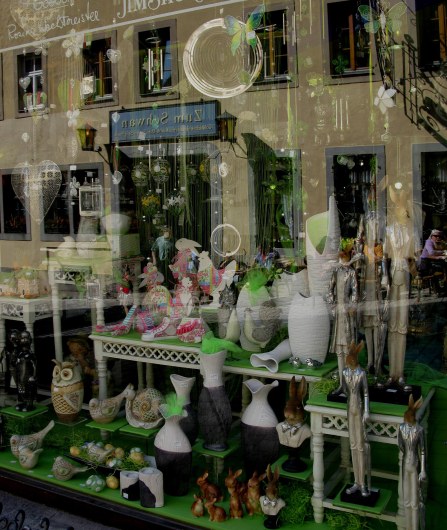
Rothenburg ob der Tauber:
saved by a knowledge of history
and a love of things beautiful
Rothenburg ob der Tauber was championed by Hitler and the National Socialists as the 'most German of German cities' and people from throughout the country were brought by bus to embed this character in their concept of the future.
As the War drew to its close, the then U.S Assistant Secretary of War, John J. McCloy, knew the historical context of the city and of it having been in existence since before 950, when the weir was built.
During World War II local bombing wrought heavy destruction, but McCloy knew Rothenburg ob der Tauber to be one of the last intact Free Imperial Cities of the Holy Roman Empire. He ordered that no artillery should be used in taking it captive.
The German military commander capitulated – against the directive of Hitler that all should fight to the death – revealing the practicality of survival. This practicality saw the citizens previously supporting the tourist boom of the Third Reich welcoming the Allieed forces.
These were choices we in other nations never had to face and as practicality and survival of one's family are our dearest priorities, we should perhaps be a bit slower to cast judgement on those who did.
Something we nations who did not have National Socialism often forget, is what is described well by Sir Winston Churchill:
In wartime, truth is so precious
that she should always be attended by a bodyguard of lies.
Two commanders on opposing sides:
both disobeying orders and thus saving Rothenburg ob der Tauber
The citizens of Rothenburg ob der Tauber showed their appreciation for the saving of their city in November 1948 by naming McCloy 'Honorable Protectorate of Rothenburg'.
After the War, the damage was quickly repaired with donations from around the world, once again demonstrating that wars are not made by people, but by governments.
For those of us with the good fortune to visit the beautiful medieval city of Rotheburg ob der Tauber, we also can be thankful that both the American Assistant Secretary of War and the German Commanding Officer acted to save this lovely city from total destruction.
As a result, we can now revel in its charm.
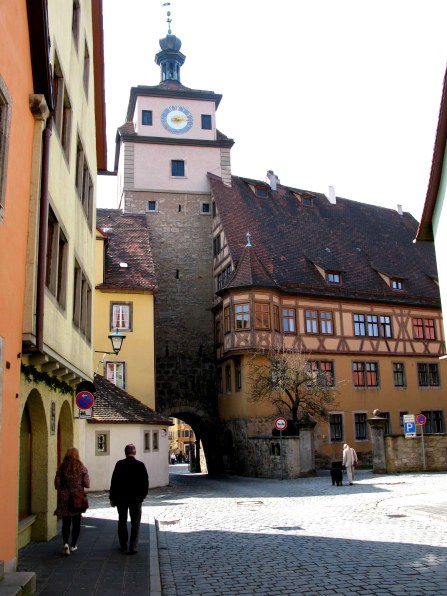
Backstreets and charm, great food and music
We can peer in its windows...
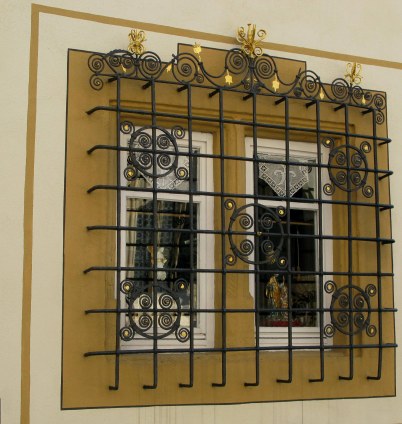
...explore its back stairs...
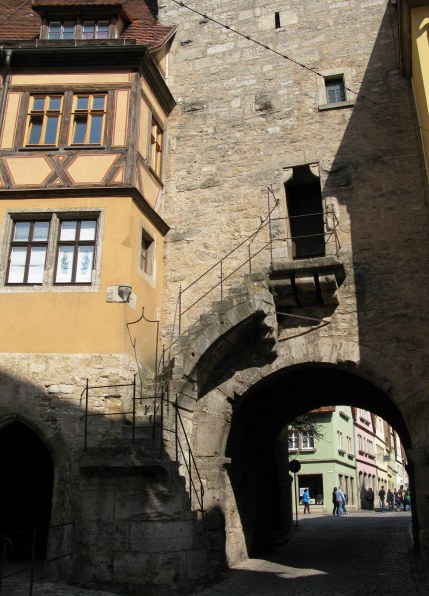
…and discover all the interesting places and corners it offers for the free-roaming curious traveller.
We can savour its delicious food, perhaps enjoyed as we did, on a terrace serenaded by the drifting melody of a choral concert in the Music Centre behind St Jakob’s church.
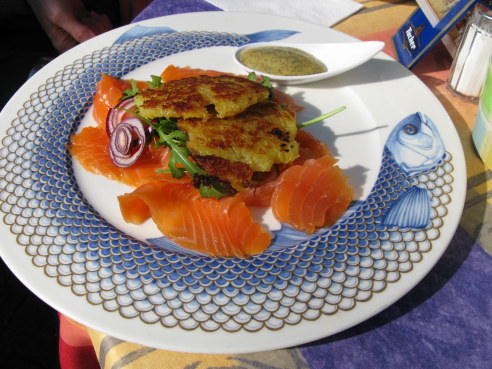
…be transported by Bavarian Coach horses…
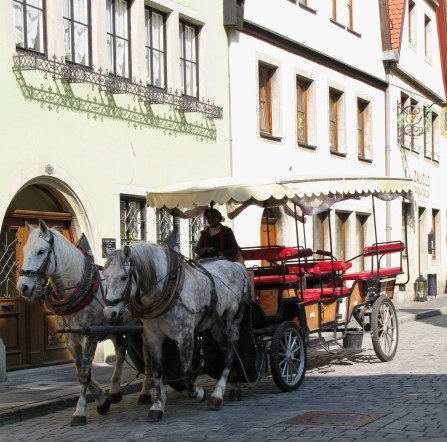
… and be captivated by the detail of the building decorations.
This doorway arch from 1596 made me wonder what its figures parodied.
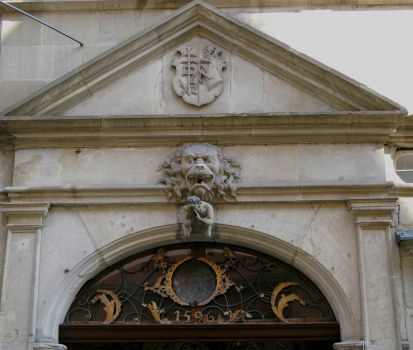
Being from a young country, Australia, which was settled by Europeans in 1788, it puts into perspective this building from 1576.
It was renovated in 1906, and following the war, again in 1954.
Now, even allowing for bombs, THAT is what we call “built to last”.
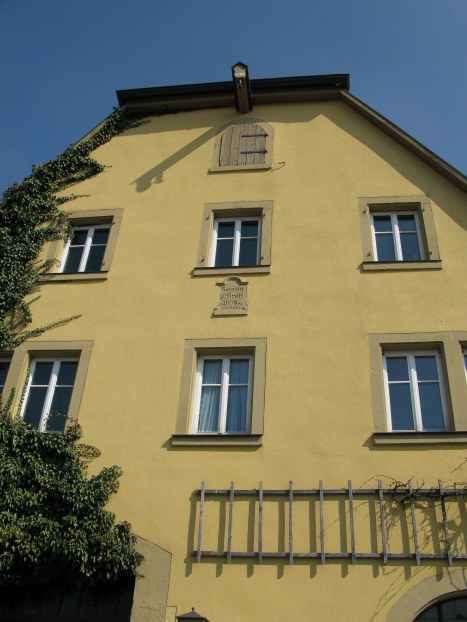
The small details are always of interest to me, whether it be the door handles…
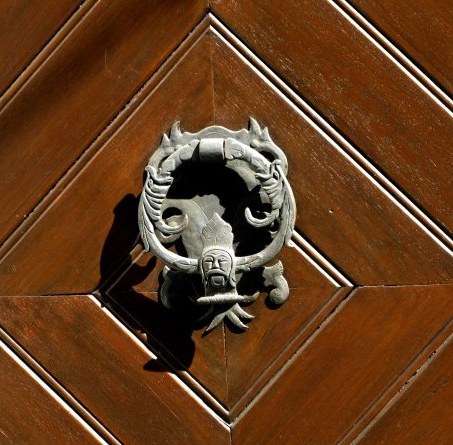
… the quotation carved above these fine doors that referred to Psalm 145...
Naturally I had to look it up and wondered whether it referred to the fact that within that Psalm:
- generation after generation are to praise the works of the Lord…or,
- given the bloody times of the past, whether it referred to Verse 19 that says that the Lord will hear the cry of those who fear him and save them.
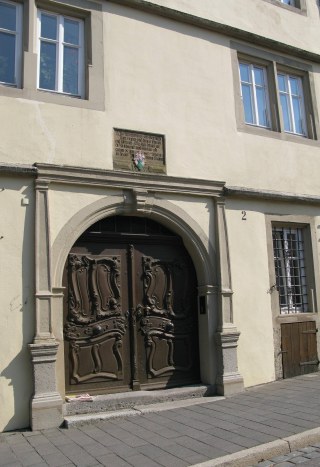
The Griffin in gold outside the guest house of the same name and the shadow patterns of its wrought iron decorative supports formed a lovely artistry in the late afternoon sunshine.
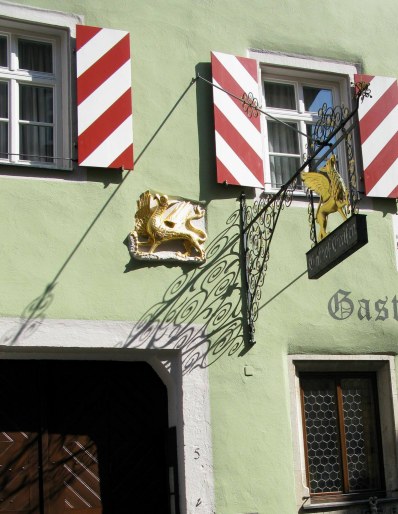
Rothenburg ob der Tauber:
a town's character reflected
It is these fine details, like the reflected clock-tower in an antique shop mirror...
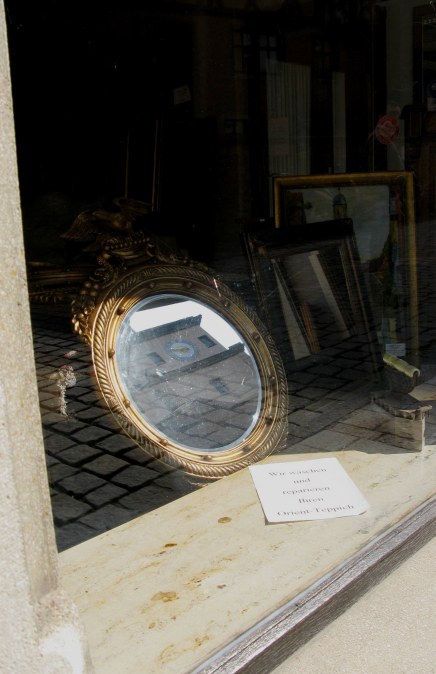
…or the still working forge with its cast goblets, glimpsed through a back-street window.
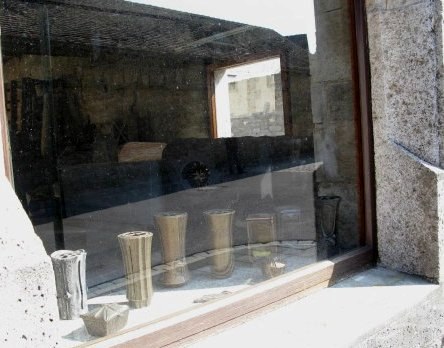
The fine facade of the Master Builder’s house was reflected in the florist's window.
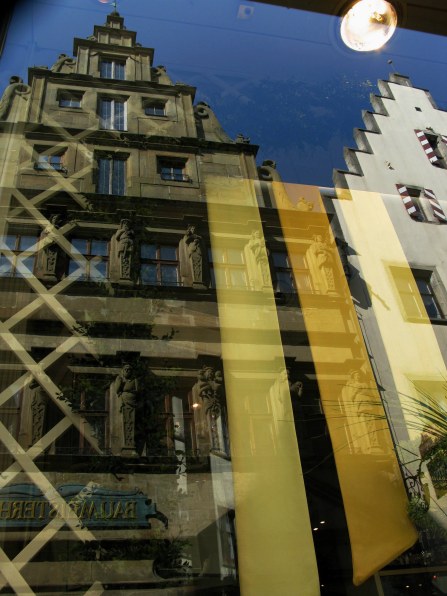
…and Steiff teddy bears made an interesting backdrop to this city building reflection.
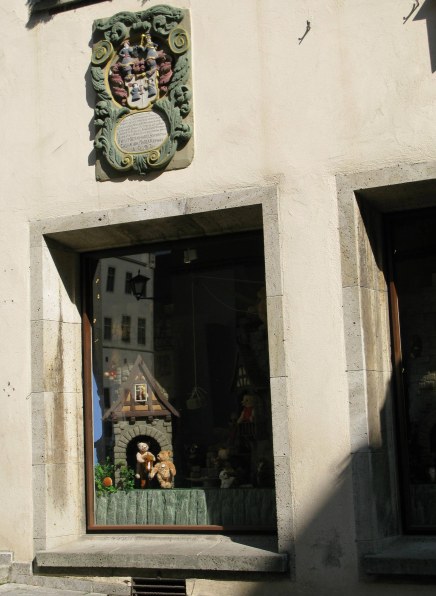
Fun and whimsy in Rothenburg ob der Tauber
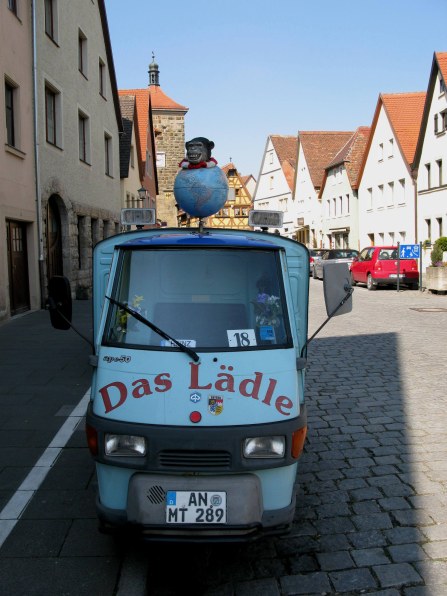
Every city has its eccentricities and small details that can be easily missed - and Rothenburg ob der Tauber is no exception.
This delivery vehicle on a back street can literally “ladel” out its deliveries in small amounts, being itself diminutive and quirky.
The cat statue sitting on the crossbeam to the inner courtyard or Hof of this house was perfectly framed between the ornate metal sign as he sat above the blue door.
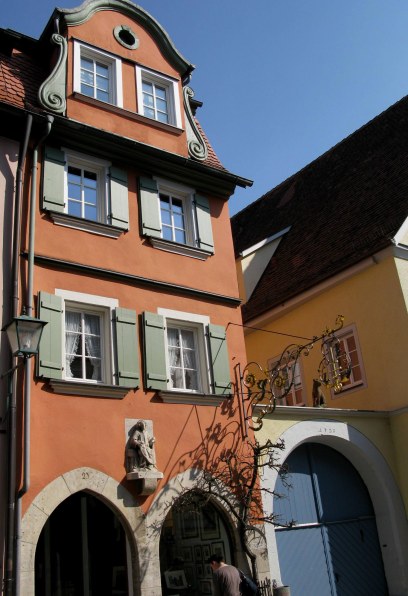
On the way back we passed a shop with local Würst, good German farm-made sausages and delicatessen 'smallgoods' displayed as carefully as items in the gift store windows.
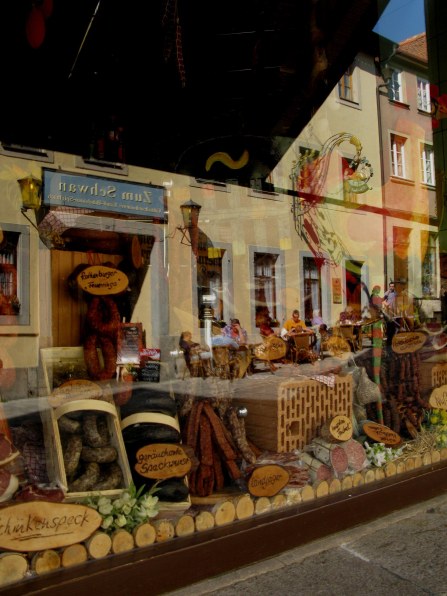
With typical German efficiency, Rothenburg ob der Tauber, catering to thousands of visitors, has clean, accessible, and free public toilets just inside the city wall.
They are in a building whose roofline architecture had attracted me on arrival.
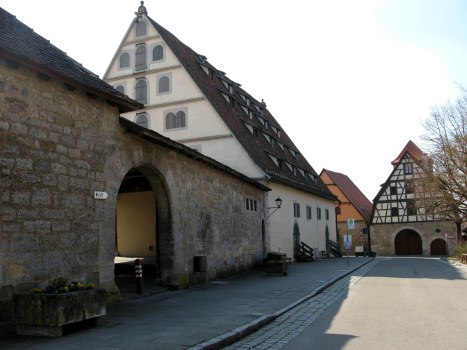
Emerging, I found myself in what would have been the horse stalls, now a parking lot from which you get a layered view of the city’s roofline.
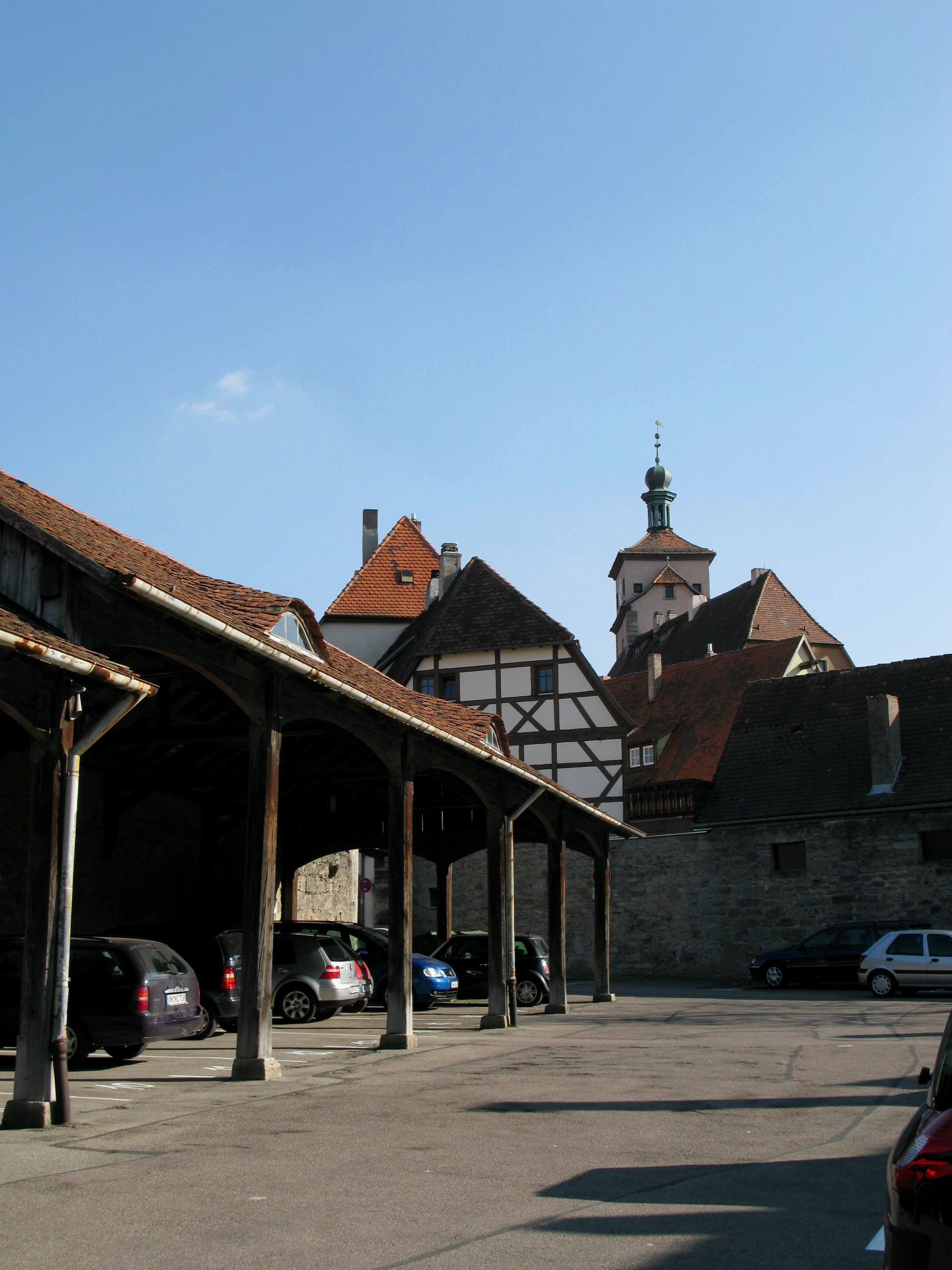
It was with reluctance that we passed back through the 13th century city wall to resume our homeward trip.
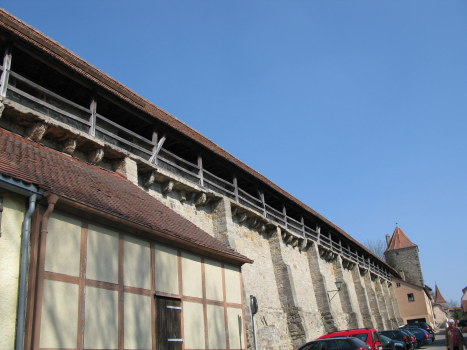
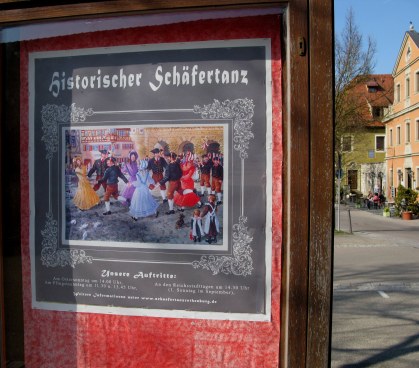
On the way this sign invited us back for the traditional Pfingsten (Whitsun) Shepherds Dance.
Seeing it, I smiled to myself. It was bound to have buses arriving full of tourists to witness the event.
Thinking about the many tour groups I had seen during the day, each dutifully following their shepherd, I was reminded of the Russian proverb:
Without a shepherd,
sheep are not a flock
More German Romantic Road Pages






